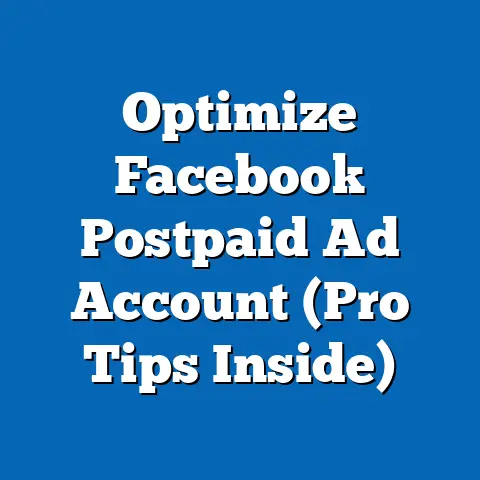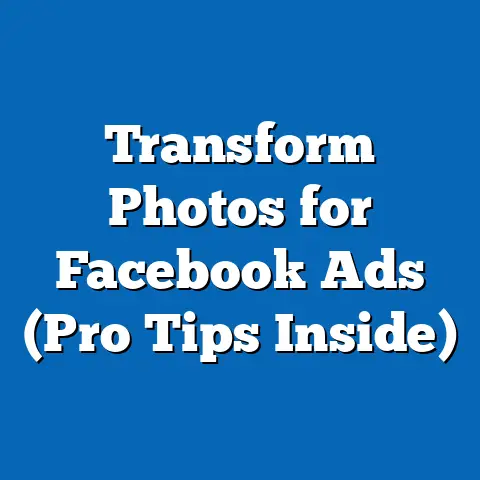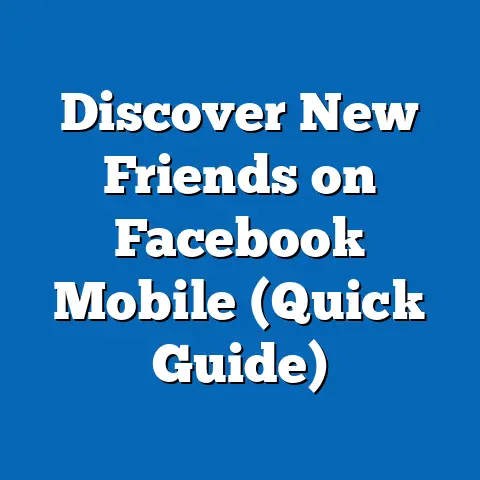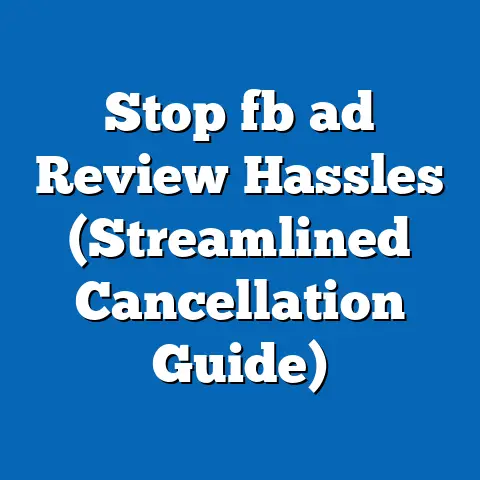Master Facebook Report Ads (Unlocking Game-Changing Insights)
Hobbies have long served as a window into the values, interests, and lifestyles of different generations, reflecting broader societal trends and technological advancements. From the stamp collecting of the Silent Generation to the gaming culture of Gen Z, personal pastimes often reveal how individuals connect with their era’s defining moments and tools. This article ties the evolution of hobbies into a deeper exploration of generational dynamics, using these personal interests as a backdrop to analyze the sophisticated world of digital advertising, specifically through the lens of Master Facebook Report Ads.
Understanding generational hobbies provides critical context for how advertising strategies, such as those on platforms like Facebook, must adapt to diverse audiences. Each generation’s unique experiences shape their leisure activities, which in turn influence their digital behavior and responsiveness to targeted marketing. By examining these patterns, we can unlock game-changing insights into crafting effective advertising campaigns that resonate across age groups.
This comprehensive analysis will explore the defining characteristics of generational cohorts, their historical contexts, and the societal implications of their hobbies, before delving into a detailed examination of Master Facebook Report Ads. We will assess how these ads leverage generational data to drive engagement, the technological and cultural factors at play, and the broader implications for marketing, society, and workplace dynamics.
Section 1: Generational Definitions and Characteristics Through Hobbies
1.1 The Silent Generation (Born 1928–1945)
The Silent Generation, shaped by the Great Depression and World War II, often gravitated toward hobbies that emphasized frugality, community, and tangible skills. Activities like knitting, gardening, and stamp collecting were popular, reflecting a need for self-sufficiency and a focus on preserving resources during times of scarcity. These hobbies also fostered social bonds in tight-knit communities, as many in this cohort valued face-to-face interaction over individual pursuits.
Historically, this generation came of age in an era of limited technology, where hobbies were often practical or tied to survival skills. Their formative years were marked by economic hardship and global conflict, leading to a conservative approach to leisure that prioritized utility over extravagance. Societally, their hobbies reinforced values of resilience and patience, traits that still influence their cautious engagement with modern digital platforms like Facebook.
1.2 Baby Boomers (Born 1946–1964)
Baby Boomers, born in the post-war economic boom, embraced hobbies that mirrored their era’s optimism and cultural revolutions. Collecting vinyl records, attending live concerts, and engaging in outdoor sports became hallmarks of their leisure time, reflecting a newfound prosperity and a desire for self-expression. This generation also witnessed the rise of television, which introduced hobbies tied to pop culture, such as following specific TV shows or celebrity fandoms.
The historical context of the Civil Rights Movement, the Vietnam War, and the sexual revolution shaped Boomers’ hobbies as outlets for activism and identity exploration. Their societal impact includes a lasting emphasis on individualism, which translates into their digital behavior today—often engaging with nostalgic content on social media. For advertisers, understanding Boomers’ preference for community-driven and memory-evoking hobbies is key to crafting resonant Facebook ads.
1.3 Generation X (Born 1965–1980)
Generation X, often dubbed the “latchkey kids,” grew up during a time of economic uncertainty and rapid technological change, leading to hobbies that balanced independence with emerging digital culture. Skateboarding, video gaming on early consoles like Atari, and collecting comic books were popular, reflecting a blend of physical and screen-based activities. This generation’s hobbies often served as escapes from societal shifts like rising divorce rates and dual-income households.
Historically, Gen X witnessed the advent of personal computers and MTV, which influenced their tech-savvy yet skeptical nature. Their societal role as a bridge between analog and digital worlds means their hobbies often combine nostalgia with adaptability—a trait marketers must consider when targeting them on platforms like Facebook, where they value authenticity over flashy trends.
1.4 Millennials (Born 1981–1996)
Millennials, shaped by the internet’s rise and the 9/11 attacks, gravitated toward hobbies that leveraged technology and social connectivity. Blogging, digital photography, and online gaming became defining pastimes, reflecting their status as digital natives who value experiences over possessions. Their hobbies often prioritize creativity and community-building, facilitated by early social media platforms.
The economic challenges of the Great Recession and student debt influenced Millennials to seek low-cost or free hobbies, often turning to DIY projects or streaming content. Societally, their focus on purpose-driven leisure translates into a demand for personalized, value-aligned advertising on platforms like Facebook, where they spend significant time.
1.5 Generation Z (Born 1997–2012)
Generation Z, born into a fully digital world, embraces hobbies that are inherently tied to technology and social media. Content creation on platforms like TikTok, esports, and digital art dominate their leisure time, showcasing their fluency with mobile devices and virtual communities. Unlike previous generations, their hobbies often blur the line between personal interest and potential income, as many aspire to become influencers or streamers.
Shaped by events like the COVID-19 pandemic and climate change concerns, Gen Z’s hobbies reflect a blend of escapism and activism. Their societal impact lies in redefining leisure as a public, shareable experience, making them a critical target for innovative Facebook ad strategies that prioritize visual storytelling and social impact.
Section 2: Historical Context and Societal Implications of Hobbies
Hobbies are not merely personal pastimes; they are deeply intertwined with historical events and cultural shifts that define each generation’s worldview. For the Silent Generation, hobbies like canning or woodworking were responses to economic scarcity, reinforcing societal values of thrift and community support. These activities laid the groundwork for a cautious approach to consumption, including digital advertising, where trust and reliability are paramount.
Baby Boomers’ hobbies, influenced by the cultural upheavals of the 1960s and 1970s, contributed to societal changes like the rise of consumer culture and mass media. Their engagement with music and sports as hobbies helped shape industries that now use platforms like Facebook to reconnect with this demographic through nostalgia-driven campaigns. However, their societal impact also includes a resistance to overt marketing, requiring ads to feel genuine and value-driven.
Generation X’s hobbies emerged during a transition from analog to digital, reflecting a societal shift toward individualism and technological integration. Their leisure activities contributed to the growth of niche markets, from alternative music to early internet forums, influencing how marketers segment audiences on social media today. Their skepticism of authority means ads must prioritize transparency to gain their trust.
Millennials’ tech-centric hobbies have driven societal trends like the gig economy and the creator economy, as platforms for sharing content became hobbies with monetization potential. Their demand for authenticity and social good has pushed advertisers to adopt more ethical practices on platforms like Facebook, where cause-related marketing often resonates. This generation’s societal impact includes a redefinition of work-life balance, influencing how hobbies are marketed as lifestyle choices.
Gen Z’s hobbies, rooted in digital immersion, are reshaping societal norms around privacy, community, and entertainment. Their preference for interactive, short-form content has led to the rise of viral marketing on social media, where engagement metrics often outweigh traditional ad spend. The societal implication is a need for brands to be agile and culturally relevant, especially on platforms like Facebook, where Gen Z still engages despite favoring newer apps like Instagram and TikTok.
Section 3: Transition to Digital Advertising and Master Facebook Report Ads
As hobbies evolved with technology, so did the mechanisms for reaching generational audiences through advertising. Facebook, with over 2.9 billion monthly active users as of 2023 (Statista), remains a dominant platform for targeted marketing across all age groups. Master Facebook Report Ads represent a pinnacle of data-driven advertising, offering detailed insights into campaign performance, audience demographics, and behavioral trends.
These reports go beyond basic metrics like clicks and impressions, providing advertisers with granular data on how different generations interact with content. For instance, a Boomer might engage more with ads featuring nostalgic imagery tied to their vinyl-collecting days, while a Gen Z user might respond to a quick, meme-driven video ad aligned with their content creation hobbies. Understanding these nuances through Master Reports allows brands to tailor campaigns with unprecedented precision.
The rise of such sophisticated tools reflects the broader shift from mass marketing to personalized engagement, driven by generational differences in technology adoption and leisure preferences. This section will delve into how Master Facebook Report Ads unlock game-changing insights by leveraging generational data, the technological infrastructure behind them, and their implications for marketing strategies.
Section 4: Unlocking Insights with Master Facebook Report Ads
4.1 What Are Master Facebook Report Ads?
Master Facebook Report Ads refer to advanced analytical tools and reporting features within Facebook’s Ads Manager that provide in-depth performance data across campaigns. These reports aggregate metrics such as reach, frequency, conversion rates, and demographic breakdowns, allowing advertisers to segment audiences by age, interests, and behaviors. Unlike standard reports, Master Reports offer customizable data views, enabling brands to drill down into specific generational trends.
For example, a report might reveal that 55% of Baby Boomers who clicked on an ad for a gardening product did so after seeing a video format, while only 20% of Millennials engaged with the same content. Such insights allow for real-time optimization of creative assets and targeting parameters. These tools are particularly powerful in a landscape where hobbies and interests vary widely across generations, as they help identify which formats and messages resonate most.
4.2 Generational Data as a Game-Changer
Generational data within Master Reports provides a roadmap for understanding how historical and cultural contexts shape ad engagement. Silent Generation users, for instance, may show lower click-through rates but higher conversion rates on ads for practical products, reflecting their hobby-driven focus on utility. Baby Boomers, with their nostalgia-driven hobbies, often respond to storytelling ads that evoke shared cultural memories, as evidenced by higher engagement with retro-themed content (Pew Research, 2022).
Gen X, straddling analog and digital worlds, often engages with ads that balance humor and informativeness, aligning with their diverse hobbies like gaming or alternative music fandoms. Millennials, driven by purpose and connectivity, show higher interaction rates with ads tied to social causes or DIY hobbies, with Master Reports often highlighting their preference for user-generated content. Gen Z, meanwhile, demands authenticity and speed, with data showing they abandon ads lacking immediate visual impact—tying directly to their fast-paced, content-creation hobbies.
4.3 Technological and Economic Factors
The effectiveness of Master Facebook Report Ads is underpinned by technological advancements in machine learning and data analytics, which allow for real-time processing of vast user datasets. Economically, the low cost-per-click for certain demographics, like older generations with less ad competition, makes these reports invaluable for maximizing ROI. However, challenges remain, such as privacy regulations like GDPR and CCPA, which limit data collection and require advertisers to balance personalization with compliance.
For younger generations like Gen Z, whose hobbies are deeply integrated with mobile technology, Master Reports highlight the importance of mobile-optimized ads. Economic factors, such as Gen Z’s limited disposable income, also mean that cost-effective, high-value offers perform better, as seen in report data on discount-driven campaigns. These insights underscore the intersection of technology, economics, and generational behavior in shaping ad success.
4.4 Cultural and Social Influences
Cultural trends, often reflected in hobbies, play a significant role in how generations respond to ads, and Master Reports capture these nuances through engagement metrics. For instance, ads incorporating sustainability themes often see higher interaction from Millennials and Gen Z, whose hobbies like upcycling or climate activism align with these values. Socially, the community aspect of hobbies—whether Boomer book clubs or Gen Z Discord groups—means ads fostering a sense of belonging often outperform purely transactional ones.
Master Reports also reveal how cultural missteps can alienate generations. An ad tone-deaf to Gen X’s cynicism or Gen Z’s diversity expectations can result in negative feedback, as tracked through sentiment analysis in reports. This cultural sensitivity, informed by generational hobbies, is critical for crafting resonant campaigns.
Section 5: Societal and Workplace Implications
5.1 Societal Impact of Targeted Advertising
The precision of Master Facebook Report Ads has broader societal implications, reshaping how generations perceive and interact with brands. For older generations, increased personalization can combat digital alienation, making platforms like Facebook more accessible and relevant to their hobby-driven interests. However, it also raises concerns about echo chambers, as highly targeted ads may reinforce existing beliefs rather than broaden perspectives.
For younger generations, the societal impact includes a normalization of data-driven personalization, blurring the lines between leisure (hobbies) and consumption. Gen Z, in particular, may face overexposure to ads tailored to their content creation hobbies, potentially leading to ad fatigue or privacy concerns. Society must grapple with balancing marketing innovation with ethical data use, a debate informed by generational differences in digital trust.
5.2 Workplace Dynamics and Marketing Strategies
In the workplace, Master Reports influence how businesses train marketing teams to understand generational nuances. Companies increasingly hire diverse teams to interpret data on hobbies and cultural trends, ensuring campaigns resonate across age groups. For instance, a Gen Z social media manager might leverage report insights to push TikTok-style ads on Facebook for their peers, while a Boomer executive prioritizes traditional storytelling for their cohort.
These tools also impact workplace technology adoption, as firms invest in analytics training to keep pace with data-driven advertising. The generational divide in tech fluency—rooted in hobby differences—means younger employees often lead digital strategy, while older workers provide historical context. This dynamic fosters collaboration but can also highlight generational tensions in marketing approaches.
5.3 Cultural Shifts in Advertising Norms
Culturally, Master Reports contribute to a shift toward hyper-personalized advertising, reflecting generational hobbies as identity markers. Ads are no longer just commercial; they’re cultural artifacts that must align with a generation’s values, whether it’s Boomer nostalgia or Gen Z activism. This shift redefines brand loyalty as a two-way conversation, where consumer feedback—captured in reports—drives creative direction.
However, this cultural pivot risks oversimplification, as not all individuals within a generation share the same hobbies or values. Master Reports must be used alongside qualitative research to avoid stereotyping, ensuring ads celebrate diversity within cohorts. This balance is crucial for maintaining cultural relevance without alienating subsets of an audience.
Section 6: Forward-Looking Insights and Uncertainties
As Master Facebook Report Ads continue to evolve, their role in unlocking generational insights will only grow, driven by advancements in AI and predictive analytics. Future iterations may integrate even deeper behavioral data, such as how hobby trends on other platforms (e.g., Pinterest for DIY or Twitch for gaming) correlate with Facebook ad engagement. This could lead to cross-platform strategies that further refine targeting across generations.
However, uncertainties loom, including potential backlash against data collection as privacy concerns mount, especially among tech-savvy Gen Z. Regulatory changes could limit the granularity of Master Reports, forcing advertisers to rely more on creative intuition than data. Additionally, the rapid pace of cultural change—evident in Gen Z’s shifting hobbies—means today’s insights may quickly become outdated, requiring constant adaptation.
Looking ahead, the intersection of hobbies and advertising will remain a fertile ground for understanding generational dynamics. Brands that use Master Reports to anticipate rather than react to trends—such as the rise of virtual reality hobbies among younger cohorts—will maintain a competitive edge. Yet, the ethical implications of such precision targeting must be addressed to ensure that personalization enhances, rather than exploits, generational diversity.
Conclusion
Master Facebook Report Ads represent a transformative tool for unlocking game-changing insights into generational behavior, rooted in the diverse hobbies that define each cohort. From the Silent Generation’s practical pastimes to Gen Z’s digital content creation, hobbies offer a lens through which advertisers can understand and engage with varied audiences. By leveraging historical context, technological advancements, and cultural nuances, these reports enable brands to craft campaigns that resonate deeply, while also highlighting the societal and workplace implications of hyper-targeted marketing.
As we move forward, the balance between data-driven precision and ethical responsibility will define the future of advertising on platforms like Facebook. While Master Reports provide unparalleled opportunities to connect with generations through their unique interests, they also underscore the need for nuance, avoiding oversimplification of complex demographic trends. Ultimately, the insights gained from these tools—when used thoughtfully—can foster a more inclusive, engaging digital landscape that respects the diversity within and across generations.






